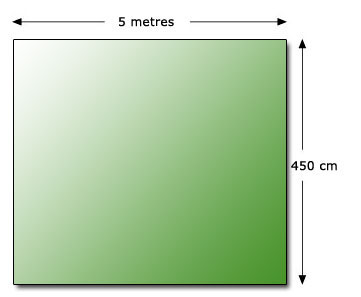3.3 Have I given due consideration to units of measurement?
Many mathematical problems include units of measurement. The measurement may be of length, weight, time, temperature or currency. The UK uses both metric and imperial units.
The table below gives the units of length that are in everyday use in the UK, but you may know some others.
| Metric | Imperial |
| millimetre | inches |
| centimetre | feet |
| metre | yards |
| kilometre | miles |
There is a great variety of measurement units in use. Their incorrect use leads to errors which can sometimes be costly.
On 23 September 1999, NASA lost a $125 million Mars orbiter. This was because an engineering team used imperial units of measurement while NASA's team used the metric system for a key spacecraft operation.

Example 10

Suppose that you want to buy a carpet, priced at £16.00 per square metre, for the room shown above and you calculate the area as follows.
Area = 5 × 450 = 2250
Cost of carpet = 16 × 2250 = £3600
An expensive carpet! What is wrong?
Answer
There is a mixture of units: metres and centimetres.
If a problem has a mixture of measurement units, it is usually a good idea to convert all measures to the same units. Here the carpet is sold in units of ‘square metres’, therefore ensure all the measurements are in metres.
Hence area required = 5 × 4.50.
Area = 22.5 square metres.
Cost of carpet = £16 × 22.5 = £360.
